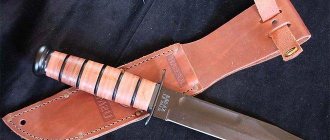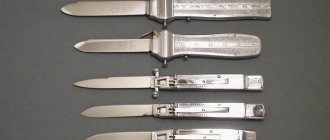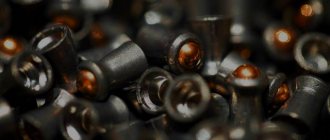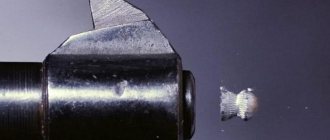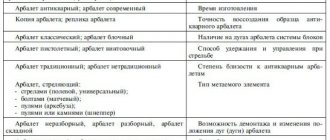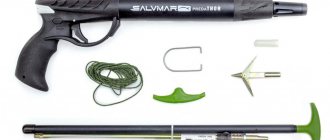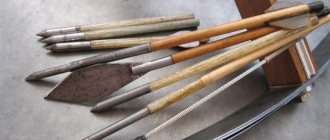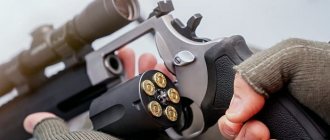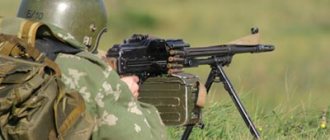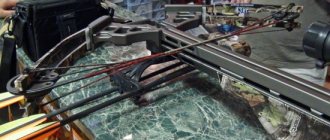What it is?
Let's start with the theory. A crossbow bolt is a special projectile that is used when shooting from specific and rare weapons. Both the firing range and its accuracy depend on the balance of the bolt, its length, and the material used in its manufacture.
It is worth noting that the choice of arrow depends not only on the crossbow model, but also on the shooter himself, so you should not waste time selecting the right projectile. It is also worth considering the fact that even with the most careful use of bolts, over time their feathering, tip, and the shaft may break - which is why it is recommended to focus on those arrows in which one or more components can be easily replaced.
In addition, you should never try to replace crossbow bolts with lighter arrows used in archery. Firstly, the accuracy of the shots will significantly suffer, because the crossbow is adapted for more powerful projectiles, and secondly, such an underload will negatively affect the crossbow itself, so you should not risk the weapon in an attempt to save money.
Crossbow bolts and crossbow arrows are not the same thing
While crossbow technology is evolving and reaching new levels, the same is happening with crossbow arrows.
Many crossbowmen automatically read bolts rather than arrows, but in fact we are talking about crossbow arrows. Many people still confuse bolts and crossbow arrows and even think that they are the same thing, but let's figure out what the difference is between these projectiles. A crossbow arrow has plastic fletching or feathers to stabilize and guide the arrow in flight. Most often, a crossbow arrow has three blades spaced 120 degrees apart around its circumference. However, some crossbows can shoot arrows with two or four blades on the arrows. These arrows typically range from 17 to 26 inches in length, but most commonly range from 20 to 22 inches, depending on the crossbow manufacturer's recommendations.
The weight of a crossbow bolt is greater than the weight of a crossbow arrow
Most crossbow arrows weigh 400-425g for compound crossbows and 350-400g for recurve crossbows. Carbon or aluminum is most often used for their production. They are very flexible and have good balance. In addition, crossbow arrows are also equipped with different types of shanks, which can be flat or half-moon to better hold the arrow in the bowstring.
photo. crossbow arrow
Unlike arrows, crossbow bolts have none of these characteristics. Crossbow bolts are significantly shorter than arrows. When it comes to the total weight of bolt crossbows, they can weigh as much as three times the arrow. This is due to the fact that they are usually made of metal and sometimes wood. They are very rigid and do not bend like an arrow. Depending on the type of crossbow, bolts receive much more kinetic energy when fired and are capable of causing significantly more damage than arrows. Bolts are not equipped with feathers, as a result of which they often lose accuracy, so they are more suitable for small shooting.
photo. crossbow bolt
Material selection
Each crossbow usually comes with a factory set of bolts. But when shooting, the arrows are lost, deformed, and completely broken. That is why, sooner or later, many shooting enthusiasts are faced with the question of making their own shells - factory bolts are not always affordable for those who use a large number of arrows.
One of the first questions to arise is the choice of material. Before you think about how to make a crossbow bolt from an aluminum tube, it is worth remembering that even this seemingly universal metal is not so durable: due to its softness, arrows quickly deform.
As for carbon fiber, which is much more expensive and durable, the bolt is unlikely to withstand a blow not against a special soft target, but against a hard target. Wood is a material for aesthetes who strive to ensure that modern bolts are as close as possible to their historical counterparts. With constant use, wood quickly breaks down, which, given its rather high cost, is far from the best option; in addition, it requires special storage and transportation conditions, and special care is also required.
Another option is plastic, which is probably considered optimal: yes, bolts made from it wear out quickly, but the material is very inexpensive, so replacing the shaft will not be difficult.
New in blogs
Crossbow (from Latin arcus + ballista) , a hand-held throwing weapon consisting of a bow, a wooden stock (machine) and a mechanical device for releasing and fixing the bowstring. In Russia it was called a crossbow, it was widely known since the 10th century, and was specifically mentioned in historical documents in 991. In the 12th century, detachments of mounted crossbowmen appeared.
Although the Greeks, for example, attribute its invention to themselves in the 4th century BC.
One way or another, on Roman antique bas-reliefs already in the 3-4th century AD you can see gastraphetes, the ancestors of the crossbow.
Positive qualities - superior to a bow in shooting range and accuracy, easier to learn, easier to use and tactics. Try to lie down with a bow drawn.
Negative features - it is more difficult and difficult to manufacture, more dangerous to use, requires strict adherence to safety regulations, the rate of fire is five to six times lower than that of a bow.
S.V. Khomyakov, A.G. Aleshin " Classification of edged weapons ."
The following types of weapons are known, differing in parts and ammunition:
Crossbow – shoots bolts.
Arquebusier - shoots lead bullets that are pushed out of the barrel
attached to the bowstring by a cylinder. When dismantling the barrel and replacing the bowstring, I fired with bolts.
Ballister, also known as schnapper , is a crossbow for shooting stone bullets. Even a non-professional can recognize it; there is no groove on the stock. And the string has a leather bullet cup.
Gastraphetes is an archaic crossbow with a stock and manual tension of the bowstring.
Doubleter - instead of a regular bowstring, two metal plates located
one on top of the other for a double shot. Ammunition - bolts.
This weapon is distinguished by the location of the arc. Because the reflexive arc is characterized by high tension; we will not mention it in the text. I’ll tell you that there are two different crossbows – peripheral and central. Peripheral - the arrow passes along the valley on the side of the straight line, conventionally meaning the longitudinal axis of symmetry of the arms of the arc, and in the central - through this straight line.
As everyone clearly understands, only classics are used at games for security reasons, because... the reflexive arc is characterized by high tension; we will not mention it in the text. I’ll tell you that there are two different crossbows – peripheral and central. Peripheral - the arrow passes along the valley on the side of the straight line, conventionally meaning the longitudinal axis of symmetry of the arms of the arc, and in the central - through this straight line.
As everyone clearly understands, for safety reasons only classics are used at games, i.e. arrows. The crossbow has taken root even in our Middle-earth, although the Professor did not mention it...
The weapon was widely known in Europe, where it came through borrowing. The first information about a collision with a crossbow can be found in the archives of the Roman Empire. In the first Crusade it was used en masse by the Arabs.
No weapon is so famous - even the atomic bomb was not banned by the councils, and the crossbow was banned in 1139 by the canon of the Council of Lotran as a “ deadly and ungodly weapon ” for use against Christians, until the 15th century.
The crossbow and lynx are the emblem of the Wehrmacht sniper school. It was the crossbow that was the weapon of the famous Wilhelm Thel (in general, it’s strange - they mention a bow in the text, but a crossbow in the engraving), it was used to kill the famous Malyuta Skuratov in Russia , as well as a huge number of uncrowned persons who had the right to the throne in European countries.
Why was the weapon given such honor? It seems to me that the correct answer is given by Kirill Eskov in “ The Last Ring Bearer ” - “The crossbowman shoots along the contour - wherever he hits, everything goes out; a month of preparation - and a 15-year-old apprentice, who has never held a weapon in his hands, will wipe his snot with his sleeve. N , winner of 42 tournaments, will hit the cap from a hundred yards
The crossbow was the first draft from the wind of change of the New Age in military affairs.
So, the crossbow was known in Rus', but did not take root in large quantities.
M. Semenova in the wonderful book “ We the Slavs ” writes that on the territory of Russia he could not compete with “ strong bows ”; for bad European bows, “ the crossbow was a step forward .” I beg to differ with this statement.
What was the hand crossbow primarily created for?
To penetrate heavy armor. The main enemies of Rus', nomads, heavy armor
did not have. The war with them took place in the steppe, where rate of fire was valued. The rate of fire of the crossbow was 2 shots per minute, while that of the bow was 10-12. It’s the same as going against the sabers of the same “smoked” ones with a two-handed sword. By the way, two-handed swords and crossbows, according to chronicles, drawings and archaeological excavations, were used in Novgorod, Galich, etc., where warriors met with enemies clad in armor. Most often in Rus' it was used in the defense of fortresses (the siege of Kozelsk in 1238), hunting and shooting from ambush. More often he could be found among the howls than among the warriors.
M. Semenova also mentions that “in 1252, in a clash with the troops of Mindaugas of Lithuania, who had German mercenaries with crossbows, our archers not only dispersed the German crossbowmen, but also, according to the chronicle, playfully shot them , racing around the field." I do not doubt this episode, although I did not find evidence of this in any sources. With whom was Mindaugus going to fight?
With Alexander Nevsky, who was respected (after the Battle of the Ice, according to the Gothic Almanac - the Battle of the Grass (reeds)) by the most powerful knightly orders? Or with the outstanding commander of Rus' Daniil Galitsky, with whom they made peace in 1248? Although Mindovg was an evil and treacherous man, he could attack.
So, an incomprehensible situation, little information. In battle, crossbowmen do not form alone, and before it comes to “persecution”, you will have to have it with pikemen. If there is a surprise attack on the convoy, then yes. Attention, question . From a distance of over 300 m, a squad of snipers can destroy a platoon of infantry in less than 20 seconds. Is it worth removing the machine gun from service?
Question two : from a distance of 30 meters, one machine gunner will destroy a squad of snipers in less than 6 seconds. Should the sniper rifle be retired? Both weapons are good in their place, in experienced hands and in an advantageous situation. So, a crossbow is a sniper rifle of the Middle Ages. Hence the originality of the tactics of application.
At the Battle of Cressy, the French crossbowmen also did not show themselves, as they were trampled by their own cavalry. So, should we admit that the French crossbow is worse than the English bow?
There are 4 categories of crossbows - for hunting, sports shooting, combat and for recreation and entertainment. A sports crossbow with a wooden (plastic) bow has a string tension of 43 kg, and 47 for a metal bow. The hunting one has 80 kg. The average combat crossbow in the Middle Ages had a tension force of 50 kg, the range of a heavy arrow was 200 meters, and a light arrow was 300 m.
Until the 12th century, crossbows were pulled by hand, from the 12th century the stirrup and waist hook came into use, then in the 14th century the “goat’s leg” appeared and at the turn of the 15th century - the gate. The toothed rack made it possible to pull the bowstring with a force of 300 kg. Thus, from the 12th century the tension force became equal to 100 kg and was constantly growing. At the time of “removal from service,” the average crossbow had a tension force of 250 kg, and a few examples were over half a ton. “ shnellers appeared - devices for smoothly releasing the trigger, which tripled accuracy.
S. Nizov's combat crossbow has a tension of 120 kg, an effective firing range of 100 m, and an initial arrow speed of 100 m/s.
With hunting and sports, everything seems to be clear. But who is fighting with a crossbow now?
Since the 2nd World War, it has taken a strong place in the arsenal of all kinds of special forces. In it, it was used by the Abwehr special forces ( Brandenburg -800 regiment ), the USS, as well as partisans - as a personal weapon and shooting traps.
This weapon is indispensable in the following situations:
1) Throwing a wire antenna for a walkie-talkie onto tall trees, buildings, etc. to increase radio communication range.
2) Installation at operation sites by remote and silent means of listening devices and radio beacons for aviation, missiles, etc.
3) For remote clearance of anti-personnel mines - with a cat.
4) To throw a safety line in the mountains to lift the first scout.
5) For silent hunting of animals and knocking down fruits, say, from a palm tree.
6) For sabotage - firing at an object with arrows with incendiary or high-explosive charges. True, they cannot destroy a tank and neither can a helicopter; here John Rambo is categorically wrong.
7) To silently destroy the enemy.
In the police, it is used to storm buildings with the help of “ cat ” (SAS, the Iranian Embassy in London in 1980 and a bunch of other “greyhound” special teams), destroy or neutralize dangerous animals (it is known that a shot from a firearm is frightening, but silent an arrow flying past may not even alert you, and a syringe ampoule with sleeping pills is easier to deliver without breaking). As well as listening devices and remote mine clearance.
In the USA, a crossbow with the M-40 index is in service with the police and special forces, in Poland it is popular in the Krakow Airborne Brigade named after General Sosabovsky; in Russia... Maybe somewhere else, but you know, it’s a military secret.
Regarding the first three types, everything is clear; in RI they are in their own capacity with their T.T.D. unacceptable. But for relaxation it may be suitable if you loosen the tension of the bowstring and make the appearance “under the game”. And such systems are difficult to obtain.
a crossbow is prohibited on the territory of Russia, a Russian combat crossbow system is difficult to get (and foreign analogues are expensive), a sports crossbow has “ bells and whistles for our business .
But, in my opinion, a crossbow is better than a bow. After all, we, modern people, are accustomed to firearms. The male part of the population received practice in handling it in the army, sports clubs, and at military training at school. And still 70% knows how to aim, and how to shoot
from a lying position he will figure it out. And any shooting athlete will be able to organize training
with a crossbow. In addition, a good crossbowman is a good sniper, verified. But there are few master archers; learning to shoot well is almost impossible.
Particular attention is paid to safety precautions.
The first thing that unwary people encounter is that crossbows trigger when they don’t want it to. We were just happy - you can always carry a weapon ready for battle, but here... There are fewer problems at the games, the arrows are not combat arrows, but it’s also unpleasant. So, on KHI-03, Korovka at the gate of the tavern received a bolt from an orchanka from our team (Lyosha, sorry again).
Secondly , the bowstring tends to injure careless fingers. At the Game near Moscow (I don’t name it - you’ll understand why) near the river I met a group of young people. In the center there were two guys in uniform, ex-special forces, they had S. Nizov’s crossbow (which they took away from the war).
They had fun shooting at a tree, there were a lot of people who wanted to... in the end, one elven youth placed his hand slightly incorrectly, the special forces soldier almost finished checking it. And the bowstring slightly cut off the meat from the fingers of the left hand. If anyone doesn’t know, grass is generally mowed with fishing line in some mowers. But the memory of the game will last a lifetime.
Third , before cocking, you must have a reflex to check that the trigger mechanism is locked when cocked. Locked - then cock it.
I would like to say right away about optics - according to the conditions of most combat rules of the Republic of Ingushetia, a crossbow with a tension of more than 20 kg is not allowed. This means that the shot range will be about 25 meters, no more. Is there a point to the sight? What they put on it - well, I don’t know what in the “cool” companies that make them, but I only came across ones with diopters. But on Nizovka there was a PO-4x24m. For those who don’t know, let me explain that this is a copy of the old PU sniper scope, only designed for a small-caliber rifle for training young snipers in DOSAAF and performing some exercises in shooting competitions.
In the Middle Ages, a steel crossbow pierced through steel armor from 100 m, felled a horse from 200 m and pierced chain mail at the same distance, and killed a man without armor at 460 meters (650 steps). At 200 m, the bolt broke 2.5 cm of the board, and at point-blank range - all 10 cm. The first steel crossbows began to be equipped with a rear sight and a front sight. With such a device, an experienced crossbowman could not miss a chicken egg from 50 meters.
Once upon a time, back in the USSR, in 1984, in the 4th grade, I watched the Soviet film “ Black Arrow ”. And a year later, the English film “Robin Hood”, or rather, it was a TV series. Well, that’s not the point, a dream arose about this weapon. My friend and I made bows in the village from the 3rd grade, it was a familiar task, we planed the stock, set it up, but then a chain of failures followed (more precisely, illiterate technical decisions). When we realized that we needed a shorter arrow, the string broke, then the bow began to “play” and finally the far from best trigger broke...
One could write that it was the crossbow that brought me to the reenactors, etc., etc., but I won’t lie - at just over 13 years old I first shot from a “small gun”, then my older friends let me shoot from an IZH-17 Born in 1952. And I quickly realized that the “trunk” was cooler, and it also rumbled so nicely. And I forgot about my dream until 1997, before my first game...
So, the crossbow consists of the following parts (our historical names in brackets):
1. Stock (strip).
2. Butt (plow).
3. Arc (self-propelled shaft).
4. Bowstring
5. Trigger (walnut).
6. Stirrup.
7. Clamp (for arrow).
8. Guide groove (valley).
all kinds of cocking mechanisms like “ goat leg ”, “ self-propelled Kolovrat ” ,
because The systems we are interested in are pulled by hand...
Egorov Alexander (Varg), Ulyanovsk, N 26 of the magazine on role-playing games “ My Kingdom ”.
Address: https://www.mykingdom.ru/mykingdom/35357 02/12/2016.
Forum of Petropavlovsk and North Kazakhstan region. Posted by Jean , 10 May 2014 04:52
Nizov's crossbow - facts and speculation
Figure address:
The inventor of the weapon, recognized by experts as the best in the world, dismantled it down to the screw
and doesn't show it to anyone else. Oryol gunsmith Sergei Nizov invented... a crossbow -
a weapon familiar to mankind since the Middle Ages.
But the Oryol designer surprised the world with a fundamentally new solution,
which gunsmiths have not thought of for several centuries of the existence of the crossbow.
He turned the bow arc in the opposite direction, which made it possible to remove the recoil force at the moment
release of an arrow from a tense bowstring. An arrow from his crossbow pierces the target
from 120 meters, and not from 70, like most other designs.
It’s good to see it at least once, in a drawing, or even better in real life. But no. Neither
the inventor has no right to show anything else. Weapons that hit specialists
dismantled and hidden.
Sergei is the only son in a family of Oryol engineers. For as long as he can remember, all the time
drew weapons, and from the age of twelve began studying strength of materials and thermodynamics, the highest
mathematics and physics. I learned all this from textbooks for senior years of technical universities.
A year before his school final exams, his father took him to the best technical university in the country.
The head of the department, a well-known professor in Russia, talked with the young man for several hours.
Then he spread his hands and asked the discouraged father: “ Why should he, in fact, act if his technical knowledge is equal to the knowledge
our fifth-year students? Let him enter the Faculty of Humanities. For us techies,
There is a lack of general human knowledge. We can't give him anything new.
This is how Sergei became a student at the Institute of Foreign Languages.
In 1996, when the guy was barely twenty, he ended up in Belgium, where he
As part of the delegation of the Ministry of Defense, I was sent to receive a certificate.
Sergei’s crossbow together, by the way, with the S-300 missile system,
patented by the Russian Ministry of Defense, entered the top ten
military inventions that received the title “ The best weapon in the world .”
Generals and colonels looked askance with displeasure when either the Americans or the Italians invited
young inventor for consultations and negotiations. Everything about this boy outraged the Russian career gunsmiths: the fact that he was the only one from the delegation who could talk to foreigners
without a translator, and that he has no special education, that no one in the arms company
I don’t know that he invented some kind of “crossbow”, competing on equal terms
with an anti-aircraft missile system.
And foreign experts turned the wonderful product in their hands, studying the design with passion. An expert from Holland, taking Sergei’s crossbow, fired several arrows in a row accurately from 70 meters
in the “ten” - a circle no larger than a penny. !!! — :))
Foreigners tried in vain to find the name of the company that manufactured it on the crossbow. They were collecting a copy to send to the world arms exhibition to the whole world: Tula gunsmiths helped make the lock, and the bow arch - for parts - at almost all Orel factories. Sergei’s father, an experienced designer, was still surprised: production was in ruins, but there were no shortage of craftsmen.
Remember how Leskov still grieved when describing Lefty: with such and such skill, one can live like that!
The character of the young gunsmith did not allow him to accept any of the tempting overseas offers he received at the world exhibition. Sergei did not want to move either to America, where he was offered to open a company, or to Italy. He did not agree to stay in Moscow, where he was offered to settle. After returning from the exhibition, Sergei received several very lucrative offers from Russian arms factories. One - very prestigious - from Kalashnikov himself. Although it was unclear
how to implement your plans in Orel, where there are no weapons factories.
In Orel, however, the inventor’s abilities were also appreciated. With the help of the authorities, an enterprise named after Sergei was opened, and almost all the necessary documents were drawn up.
All that remained was to obtain a state license. Crossbow with the proud name "Eagle"
would noticeably displace well-known arms brands on the world market. The cost of one of these
which was invented by Sergei Nizov, no less than 2000 USD. Know ours!
However, you can modernize the most advanced weapons as you like, but not the Russian one
official car. No inventor has yet succeeded in doing this. Exactly two weeks later
After Sergei returned from Belgium, difficulties began to arise for the Russian crossbow and its experts and connoisseurs. First - in the form of tightening the instructions of the Ministry of Internal Affairs, and then at the legislative level.
Sergei considers the main cause of all the troubles that have complicated the life of the Union of Crossbowmen of Russia ,
a member of the board of which he was, the hype surrounding his invention. In the law on weapons,
quite liberal for firearms, any right of ownership is now excluded
Russian citizens with a crossbow.
These weapons can now be purchased, transported, improved, produced and sold
only a state institution, to which Sergei Nizov’s enterprise did not belong.
The crossbow is recognized as a particularly dangerous weapon. By the way, according to the new law, a slingshot with the energy of a “shot”
more than 20 kilojoules is also a weapon that poses a danger to society.
In order not to contradict the law, Sergei his crossbow, recognized as the best weapon in the world in 1996,
I had to take it apart and hide it.
At the same time, crossbows are imported into our country from abroad. The crossbow has become very fashionable
worldwide. The World Crossbowmen's Union was founded. For the first time in the world, Belgium hosted
championship in shooting from this weapon. There they appreciated Sergei's invention. In Russia, one very high official told Sergei that his activities
is illegal and subversive.
— Why? — the inventor was surprised.
— Because you're setting a precedent. If you, self-taught, can make such a weapon,
why not try others too?
According to the new law on weapons, today Sergei cannot even draw crossbows.
This will already be the development of weapons, which is punishable by law.
Today, however, after four dozen patented developments, more than half
which are classified, he himself considers that crossbow to be the baby talk of a self-taught beginner.
And the secrecy of the inventor led to the fact that we cannot publish his portrait in the newspaper.
Also, some theoretical discussion on the landing forum:
He was awarded the prize for the invention of “reverse arms”, and not for the quality of workmanship...
Experts said about the crossbow that it has greater power and less tension on the bowstring.
by M.K. The “speculations” of this article are similar to “ clarity is one of the forms of complete fog .”
Here's a joke about more than 20 classified developments of S. Nizov for ... “ineffective weapons” ??-:)
Yes, sabotage, alas, is possible... but Jin here “carried game” that I had never seen before:
- Less likely - Nizov’s crossbow was tested in Afghanistan without much success,
after which it safely rotted in warehouses, with the exception of a couple of pieces.
— It is more likely that the crossbow developed by Nizov was once sent in a quantity of 5-6 copies for “running in” in the Special Forces unit, where it was safely “buried”, being considered ineffective ,
and during Perestroika and general chaos, officers simply dismantled the remaining copies
home as a keepsake.
— The most likely thing is that Nizov’s crossbow really existed, but was rejected as
ineffective weapon . Now he is gone, but rumors and legends remain - and now everyone
a more or less serious device will be called after the non-existent Nizov crossbow...
Photo:
Address: https://nasmnogo.net/index.php/topic/10400-arbalet-nizova-fakty-i-domysly/
M.K. Let's look at the ratings of the crossbow in the article: Crossbows - Desantura.ru - about landing without borders
Alex Wolf User Posts: 249 Registration: 08/01/2005
Dear ones, let’s put some kind of system in place, otherwise it’s difficult to reason.
To begin with, the advantages of a crossbow.
- Silence of shooting.
- Wide range of projectiles, such as arrows, grenades, beacons, alpine
- agents, packages with chemical, biological or incendiary contents, etc.
- Non-attachment to the caliber and type of projectile thrown.
- Unlimited number of shots.
- No open fire when firing.
- Stunning effect.
Now the disadvantages.
- Low rate of fire.
- Zeroing is required depending on the mass of the projectile, or a sight with weight adjustment.
- Heavy crossbows require a lot of physical effort to cock.
- Inconvenient shape when assembled.
- Loading difficulty
- The following conclusions suggest themselves:
- Use in combat conditions is out of the question.
- Very suitable for carrying out sabotage and terrorist operations.
- Effective in mountain conditions for establishing suspended crossings.
- Can and most likely is in service with numerous special forces
- I don’t know here, but in a magazine I saw a photo of Americans training in crossbow shooting.
- It may appear in the arsenal of terrorists, which is not pleasant.
M.K. In the same article we look at an excerpt from the book “Special Operations Forces” by N.L. Volkovsky :
“ Modern models of combat crossbows have been adopted by special operations forces in many countries around the world. According to some characteristics, the crossbow was ahead of firearms in specific conditions of use.
The effective shooting range depends on the material and size of the bow, the material of the string, the arrow used, and the sight used. In combat crossbows, bows made of composite or highly elastic alloy steel alloys are used. Their energy capacity often exceeds the muzzle energy of a 9x19 Parabellum cartridge fired a pistol or submachine gun. In addition, a combat arrow, having excellent aerodynamic qualities, loses energy in flight more slowly than most bullets.
In general, a combat crossbow is superior in accuracy and shooting accuracy at a distance of 50-100 meters to most submachine guns, maintaining firing efficiency up to 150 m.
As for the lethal effect of arrows, it is quite high and if they hit vital organs, the enemy dies instantly.
However, arrows have another advantage - the use of special non-removable tips guarantees serious injury to the enemy. Arrows are also dangerous for body armor,
which do not use steel (ceramic) plates. The fact is that it is extremely sharp
the tip does not tear, but pushes the threads of the protective fabric apart, and an arrow with such a tip
will “spread” the fabric body armor and reach its wearer.
The combat crossbow is used as a multi-purpose device. In addition to secretly destroying the enemy, it is used to overcome obstacles, since it can be used to stretch a thin but strong thread across a river or abyss.
In the same way, wire antennas are thrown onto trees or buildings to increase the communication range of a special group located behind enemy lines. destinations with the “mainland”.
Using a crossbow, you can install listening devices and reconnaissance and signaling devices at an object that is impossible to penetrate in the usual way.
They use a crossbow to obtain food by hunting animals and knocking fruits from tall trees.
In terms of versatility, it is significantly superior to firearms.
Regarding the noiselessness of a crossbow , we can say that the sound of its parts is significantly lower than when fired from an air rifle. The absence of touching metal parts eliminates the clunking noise that is typical of even the most advanced silent firearms.
Special operations forces view the crossbow as a combat weapon primarily due to its exceptional quietness. Thus, crossbows today are increasingly taking their rightful place in the arsenal of special forces units.
— Who are reserve officers? - Reserve officers are the ones... who will hoist the banner on the roof of the Reichstag! (With) "
p/p-to Volkov.
Original: https://desantura.ru/forum/forum36/topic1149/?PAGEN_1=2
M.K. Crossbows are used in the armies of the leading countries of the world. Let's look at their data and their application .
Ukrainian Association of Gun Owners.
From the article: Tactical crossbows in the army 02/25/2016. Author: Web admin
The end of the sixties gives a new impetus to the development of these weapons. The Cold War demanded
silent and effective weapons for special forces, but its creation by the United States somehow
it didn’t work out, all of their samples were noisy and had disgusting ballistics.
This is where we remembered the crossbow. The presence of computers made it possible for scientists to calculate the parameters and materials for an ideal (at that time) crossbow. By the mid-seventies, more than a hundred copies of this weapon were tested in special forces of the Marine Corps.
The tactical crossbow, despite its light weight and dimensions, was a single-shot weapon that required a relatively long time to reload. The soundlessness of the shot was not absolute, but it was several times less than that of an M16 rifle with a silencer. When fired, the bowstring produced a characteristic clap, audible at thirty meters (but it attracted little attention, since it did not look like a shot). Despite these shortcomings, US special forces have used the crossbow in sabotage operations around the world for more than fifteen years.
In the mid-1980s, block crossbows became widespread among the troops. Their design is such that, when cocked, it creates virtually no force on the lock, and at the same time, when straightened, the shoulders develop greater force on the bowstring, which means the range and accuracy of the shot increases.
( Note by M.K. Today there are a number of variants of the block crossbow. For example,
“... a crossbow is an accurate weapon, partly flexible, and most importantly silent. The laws in the Russian Federation are very harsh, there are restrictions, and throwing weapons are prohibited. For example, in the USA there are no such prohibitions, which is the reason for the rapid development of crossbow hunting in this country.
The rating is based on statistical data from American shooters.
In first place is the Excalibur Matrix Mega 405 crossbow.
Boom speed – 124 meters/second; tension - 132 kg; weight – about 3 kilograms.
This is the development of the Canadian brand Excalibur . The model has been on sale since 2014.
As eyewitnesses say, you can even kill an elephant with this crossbow»!
Address:
https://www.hunt-guns.com/about-hunt/for-the-hunter/samyye-moshchnyye-arbalety-dlya-okhoty)
The main tactical crossbow of the US Army special forces, a representative of “ block guns ” . Due to its huge eccentrics, the width from axis to axis of the blocks when uncocked is 43 centimeters, and when cocked it is 29 centimeters. The stroke of the bowstring is generally a record for a crossbow - forty-five centimeters! With a peak force of 77 kilograms, it is capable of sending an arrow weighing 425 grains (26 grams) at a speed of 125 m/s. At this time, this is an absolute record for tactical crossbows. The kinetic energy developed in this case of 217 joules is sufficient to penetrate a person within three hundred meters.
Tactical crossbow PSE “TAC 15″
The crossbow is unusual in that the back of the crossbow is from an AR-15 (M16) automatic rifle, so any weapon based on the M16 can easily be converted into a crossbow. The TAC-15 has a built-in winch-type cocking device. One more point - the arrow of this crossbow does not lie on the guide, but, like a bow, rests with its leading edge on a shelf, this made it possible to increase the initial speed of the arrow's flight. And the arrows recommended by the manufacturer also have a record length for crossbows - 26 inches, which is approximately 66 centimeters.
By the early nineties, the shoulders of crossbows began to be made of carbon fiber and other composites, which, in combination with a block design, made it possible to achieve simply enormous power, often exceeding the power of a conventional army pistol.
A modern tactical crossbow is, in fact, a weapon ideal for special forces. The choice of bolts and tips for a crossbow allows it not only to effectively hit living targets, but also to throw communications equipment into trees, deliver transmitters to a protected area, or silently obtain food in the forest. With its help, you can overcome an obstacle such as a gorge or river by throwing a thin and durable cord over them. The arrowhead of a crossbow may have an explosive warhead...
Modern crossbows are mainly equipped with an optical sight and a laser designator, which has significantly increased shooting accuracy. A good combat arrow does not lose its destructive power at a distance of three hundred meters; At the same time, the body armor will not protect from it - the sharp tip easily pushes the Kevlar threads apart, reaching the body...
China:
All units of the People's Liberation Army of China are armed with crossbows
– ranging from traffic police to special forces.
They have a crossbow, which is the same basic weapon as the assault rifle.
India:
Indian Marines until the late 1980s. were armed with crossbows, the tips of which were treated with cyanide. Crossbows were used as an alternative to pistols, which were banned in this country. Today such weapons remain
only from Indian counterintelligence special forces.
Original: https://zbroya.info/ru/blog/5267_takticheskie-arbalety-v-armii/
With deep respect to all of you, Mikhail Kozhevnikov. 03/13/2016.
PS
There are three types of crossbows depending on the tension of the bowstring. “ light ” category includes models with forces up to 27 kg. Medium crossbows have a pulling force from 27 to 110 kg.
In the Russian Federation, the free sale of crossbows with a tension force of up to 43 kg is allowed. “ Heavy ” crossbows are those with a pulling force of more than 110 kg. These are combat vehicles, and their weight reaches 10 kg or more.
| Crossbows Interloper Tactician or Skald. These are the only crossbows certified in Russia, with an arrow speed of up to 400 feet (up to 160 meters) per second at a price up to $1000 and allowing you to hunt wild boar at distances of 100 meters. |
9x40 sights allow the use of INTERLOPER crossbows at distances of 80-100 m on a boar for shoulders up to 43 kgf without restrictions, as well as at distances of about 150 meters on foreign hunts with shoulders of increased power, the circulation of which is not prohibited in Russia.
Interloper Tactic crossbows are purchased by Russian law enforcement agencies for the training of special forces and the organization of sports and leisure activities in departments, higher educational institutions and PG units. Crossbows are used by clubs and organizations throughout Russia and the CIS countries for sports and cultural work.
Original: https://www.ebftour.ru/gallery.htm?id=10032
M.K. Copying Nizov's crossbow in the USA under a license from the Russian company "Armcross" and without it!
Vengeance crossbow was first presented by Barnett at SHOT Show 2012 , the largest arms exhibition held in January 2012 in Las Vegas (USA).
The license to produce similar crossbows with reversed shoulders (RDT) was acquired by Barnett from ... the American company Scorpyd. ??-:))
( NOTE by Mikhail Kozhevnikov about the fake crossbow from the Scorpyd :
«Oh, how many wonderful discoveries the hunting revolutionary Newtonian Jim Kempf is preparing for us.
First, a little history. Reverse Draw Technology Crossbows, as it is called in Scorpida, or the technology of reverse arrangement of the crossbow string (as it is incorrectly called by the people of “bullpup” crossbows - “bullpup” this phrase has nothing to do with it at all), was not born at all in 2003 thanks to “innovator” Jim Kaempf.
… Jim, let’s not make the Russians laugh with your pioneering discovery, and we’ll forget about the idiots who stole the 1000-year-old crossbow “innovation.” »
Address: https://www.nExplorer.ru/news__11330.htm ).
In our country, similar crossbows are produced by the company Armcross.
They are sold under the name "Leo Pro". The American company Horton produces hunting crossbows under the Armcross license, but their sale in Russia is prohibited.
Crossbow BARNETT Vengeance RUR 66,000.00 Article: 78201R Color Black REALTREE MAX-1 Quick order Manufacturer: BARNETT OUTDOORS LLC Purpose: Hunting Type: Block.
Muzzle velocity: 365fps* (111 m/s) Bowstring stroke: 18.00″ (45.7 cm).
Draw Force: 95lb (43kg) - 140lb (64kg) Axle to Axle Width: 21.25″ (54 cm) gr
From the description (active tab) Characteristics. Color options.
Introducing Barnett's Vengeance, the next step in crossbow technology! This is the first crossbow in history to combine a lightweight CarbonLite technology with a reverse shoulder design .
The new design rotates the shoulders and, accordingly, the heaviest parts - the shoulder pockets and pads - closer to the lock, while significantly reducing the weight in the front part. The center of gravity shifts towards the shooter, which radically improves balance and increases shooting comfort, almost completely solving the problem of fatigue when shooting handheld.
In addition, the length of the crossbow has been reduced by the length of the block and bow, which previously protruded from the front of the crossbow. Used in the Vengeance, as in other Barnett crossbows, the bullpup design further reduces the overall size, making it very compact and easy to use. The combination of the bow's reverse swing and CarbonLite Riser provides consistent and more accurate shots than traditionally built hunting crossbows.
The crossbow has a mount for a quick-release shako, which allows you to attach other accessories, such as a flashlight. The shako itself can be secured outside the crossbow thanks to a special clip. Two color options complete the look of one of the most technologically advanced crossbows of our time: the Vengeance is available in Carbon (Black) and RealTree Camo. The equipment from the friendly company CROSS and arrows from Easton allow you to start using the crossbow immediately after purchase. Equipment: Shako. Three carbon arrows 3x32 optical sight with illumination. Manual tensioner.
Replaceable butt plate for the butt. The Vengeance accepts 20″ and 22″ crossbow arrows.
Original: https://www.arbalet.ru/arbalety-blochnye/barnett-vengeance
A little more theory
What do “crossbow bolts for sports” and “bolts for hunting” mean? The difference between them lies in the material of the shaft: in the case of a hunting arrow it is heavier, while in a sports bolt it is hollow. As for the tip, in hunting arrows it has much more edges and notches than in sports arrows.
The fletching of sporting bolts is shorter than that of hunting bolts: in the latter case, the arrow needs to quickly stabilize, and this quality is ensured by a long fletching, which can be made from either plastic or ordinary feathers.
Ideal Bolt Parameters
Now that we already have a certain information base, we will learn how to make crossbow bolts with our own hands. Let's start with the parameters of the product: its length should be 30-40 centimeters with a diameter of 6-9 millimeters. As for the plumage, its length should not exceed 7 centimeters. The finished bolt should weigh from 15 to 40 grams. Typically, bolts are made in small, but still batches, for example, five shells at a time. In this case, it is important that they are as identical as possible - this is what guarantees the same results when shooting. It is worth remembering that the thinner the shaft and the shorter the tail, the better the aerodynamic qualities of the bolt.
DIY plastic bolt. What will you need?
So, how to make a crossbow bolt with your own hands? Let's try to design a simple pistol-type dart. To do this, you will need a plastic tube from a balloon, a holder for it (round, put on a stick and helps maintain the position of the balloon), a rivet, a nail (length - 12 cm, width - 4 mm), plastic for the plumage (thickness - 0.3 mm , and the length and width are 70 and 18 mm, respectively).
The tools you will need are a stationery knife and a thermal knife (the latter is a modification of a soldering iron, on the tip of which a blade is attached, and when heated by the soldering iron, it will serve perfectly for cutting holes for the feathers), a hacksaw for metal, a drill with a drill bit (5.5 mm in diameter), a file and a silicone glue. A template according to which the feathers will be cut is also required.
Manufacturing instructions
It all starts with sharpening the rivet. To do this, you need to clamp it in a drill and gradually sharpen it using a file. After this, the ball stick is cut in half crosswise, and then cuts are made in the resulting tubes to insert the feathers - these operations are best done with a thermal knife.
In the ball holder, its upper part is cut off, which is attached to a stick, cut in half and drilled out with a drill - this is the future end of the bolt shank. Naturally, the bolt needs to be made heavier; to do this, the head of the nail is cut off, then it itself is cut in half, and after these manipulations one of the halves is inserted into a plastic tube (the nail should take up 2/3 of the future bolt). After this comes the turn of the plumage: peculiar trapezoids are cut out of plastic.
Now that all the parts are ready, you can assemble the bolt. First, a tip lubricated with silicone glue is inserted into the plastic tube about a third of the length. Then a nail lubricated with glue is also inserted from the back side; it should rest against the back of the rivet. After this, plastic trapezoidal blades are glued into the slots for the feathers, and the manufacture of the bolt is completed by a tip cut from the ball holder and glued to the rear end of the stick.
Replacing plastic with aluminum
When making crossbow bolts with your own hands, you can use aluminum as a material for the shaft. The properties of darts made from this material have already been discussed above - it is relatively soft, so it inevitably deforms over time.
At the same time, the use of a metal tube in the manufacture of a bolt according to the same scheme as presented above will help to significantly strengthen the structure, adding weight and strength to it.
Why are crossbow arrows called bolts?
Firstly, the term “bolt” in relation to crossbow arrows began to be used for commercial purposes by manufacturers themselves more than 30 years ago in order to distinguish crossbow arrows from bow arrows by name.
Secondly, initially bolts were used to shoot crossbows, and when arrows appeared, many, out of inertia, continued to call them not arrows, but bolts.
In fact, practically no one shoots with bolts in their literal sense anymore. Modern crossbows mainly shoot arrows specifically designed for them.
Thus, the difference between crossbow arrows and bolts is very significant, both in design and in characteristics. Perhaps for many this information will be useful in order to understand ammunition more thoroughly.
Wooden crossbow bolt
In conclusion, I would like to return to classic wooden darts. The crossbow bolt, the photo of which is presented below, is made of wood. The ideal material in this case would be birch, which, although not easy to process, will make bolts very strong. The bead that goes to the shaft is most often square, but sometimes there are also so-called dowels - already rounded sticks.
In the case of initially square shafts, you will have to use a plane to give them an octagonal shape, and then gradually sand the shaft with increasingly less coarse sandpaper until it is perfectly smooth.
In this case, it is better to make the tail from aluminum tape - it is quite strong and will also give the bolt the weight it needs for long-distance flight.
Rectangles are cut out of aluminum tape, which are then covered with other, bright tape, which will help you find the arrow in the grass. In this case, on one side of the resulting structure, identical feathers are cut out using a template. Using the same silicone glue, they are fixed in the openings cut into the shaft.
To create a secure tip, a coin is attached to the upper end of the shaft with electrical tape. A little polyurethane foam is squeezed onto it from above, and then the entire structure is covered with fabric. Such a tip will not penetrate the target, but at the same time it will not cause any harm if used carelessly. So, the wooden crossbow bolt is ready.
Crossbows: questions and answers
How to string a new bowstring on a recurve crossbow? I'd like to go hunting. How much tension should you use to hold a crossbow? When I put a new string on my crossbow, it feels like it's too short and that the bow is too tight. What's the matter? I purchased a PSE recurve crossbow that shoots seventeen inch (17″) bolts, and now I can't replenish my ammo with arrows of the same length...all I have are twenty and twenty-two inch (20″ and 22″) bolts. What advice would you give me? Could you explain to me why a crossbow arrow is called a bolt?
What is the difference between a compound crossbow and a recurve crossbow?
The basic components of these two types of crossbows are almost the same. Their main difference is in the method of attaching the bowstring to the shoulders. In a classic recurve crossbow, the string is attached directly to the ends of the arms and is thus directly responsible for pulling the bow back and bringing the crossbow to its full cocked position. A compound bow uses a pulley system to reduce the effort required to draw the crossbow string. The wheels of this system are located at the ends of the arms. A rope is stretched through them, and they rotate at the moments of tension and release of the bowstring.
How to string a new bowstring on a recurve crossbow?
Stringing a new bowstring on a recurve crossbow is very easy. Even in the field, stringing will only take a few minutes if you want to change a bowstring that is worn out but has not yet burst. Place the left or right end of your shoulder into the ground between your legs (to prevent the crossbow from slipping) and press until the string slackens. Remove the old string from the shoulder and immediately place the loop of the new string over it. Then simply remove the old string from the other arm. Continue bending the bow until you can loop the new string over the end of the second limb. Slowly release the pressure...and you're done! We recommend drawing the crossbow and marking the “dead center” on both sides with a white or bright marker. And don't forget to wax your new bowstring to increase its lifespan.
I'd like to go hunting. How much tension should you use to hold a crossbow?
You will be surprised how many people do not know that all crossbows have different draw weights and that you need to select a different crossbow for each animal. Draw weights range from 22.65 kg (50 lbs) for pistol crossbows to over 90 kg for full-size crossbows. Accordingly, the bolt flies out at a speed of 39 m/s, and in the second case at a speed of 90 m/s.
But what tension force and bolt release speed are needed for regular hunting?
If you want to shoot a few birds, a hunting crossbow with a draw weight of 30 kg (67 lbs) is just what you need. The bolt will fly out at a speed of 29 m/s to 34 m/s. This tension force and bolt speed are enough to hunt turkey, antelope and even deer, if you get right into its killing zone.
Believe it or not, rabbits are quite cunning and fast creatures, and it can be quite difficult to shoot them with a crossbow. Hearing the sound of a lowered bowstring, they immediately wag to the side, bend down or jump. Due to the small size of the animals and their affected area, the speed of the bolt is more important for a crossbow. You need the fastest bolt that can hit the nimble animal, and not the grass on which it was sitting.
For larger animals with thick skin and a thicker layer of blubber, such as deer, caribou or small bear, you will need a crossbow with a draw weight of 40 kg (88 lbs). Remember, these animals are not fast enough to move out of the path of an arrow or bolt. You only need brute force to break through the beast's kill zone. Some 88 lb (40 kg) crossbows launch bolts at 45 m/s.
If you want to go hunting for really big animals (moose, bear or buffalo), a 95-pound (43 kg) crossbow will help you. The bolt speed will be about 50 m/s.
Before you start hunting these amazing animals, it would be a good idea to practice shooting. You cannot afford to miss a bear from 35 meters, knowing that an angry bear will be able to cover this distance in 6 seconds, and you will need 5-10 seconds to reload your crossbow. First, hunt for those who will not kill you if you miss, for example, a small rabbit.
Now you know what tension force is used for different hunts, all that remains is to choose a weapon and go hunting.
When I put a new string on my crossbow, it feels like it's too short and that the bow is too tight. What's the matter?
I assume you are talking about a recurve crossbow and not a compound crossbow? First, make sure that you purchase a bowstring that is the right size for your crossbow. If you still have an old bowstring, just compare them. Otherwise, check your owner's manual or manufacturer's website for the recommended string material and length. If you are sure that the bowstring is the correct length and is made of the recommended material (for example, Dacron), then most likely you simply do not have enough strength to draw a recurve crossbow. A crossbow with a draw weight greater than 68 kg can be quite heavy to draw. To make tensioning easier, you can purchase a tensioning device. Many new crossbow models also have a foot stirrup (rail), which allows you to hold the crossbow with your foot and pull the bowstring with both hands.
I purchased a PSE recurve crossbow that shoots seventeen inch (17″) bolts, and now I can't replenish my ammo with arrows of the same length...all I have are twenty and twenty-two inch (20″ and 22″) bolts. What advice would you give me?
You can use eighteen or twenty inch (18″ or 20″) carbon arrows without any problems, you just need to choose the right diameter and weight.
Could you explain to me why a crossbow arrow is called a bolt?
Good question.
Previously, the crossbow arrow was called "quarrel", from the French word "carre" - square, as it had a square tip. The name “bolt” most likely comes from the English word “to bolt” - lightning strike, hinting at the fast and sharp flight of an arrow. Or perhaps the name is also given due to the shape of the arrowhead. Nowadays no one says quarrel anymore, and calling a bolt an arrow is also not entirely correct. Good luck in your search for the best crossbow.
